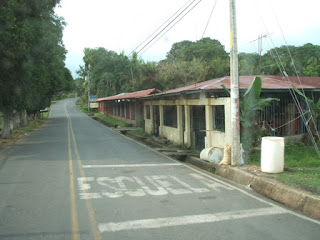Yesterday we stepped ashore for our pre-booked excursion to the Costa Rican cloud forest at Monteverde in the country's central highlands. This was our first ever visit to a Central American nation and upon arrival, it was immediately apparent that we were in a very different part of the world.
After a smooth and orderly debarkation, we boarded the minibus which was waiting for us on the dockside. The ship berths at a purpose-built cruise liner jetty extending from the beach in the town of Puntarenas. The town is also capital of the Puntarenas state, which geographically spans the entire Pacific coastline from the Nicaraguan border in the north, to Panama in the south. It's a medium sized town, built on a natural peninsula near the top of the Gulfo de Nicoya. Initial impressions were of a shabby but functional town, set in an area of contrasts: beautiful scenery, beaches, mountain backdrops and tropical plantlife, but tapered with run-down buildings, unkempt streets and other scenes of general dereliction and occasional poverty. Contrary to what we had read on some of the cruise forums, there was nothing seedy about the town however - just an ordinary town with ordinary people going about their business.
Costa Rica is a developing country with a population of about four million citizens, and one of the most prosperous in Central America. Relying heavily on tourism, its biggest exports are coffee, bananas and according to our tour guide, microchips from computer giant Intel, who have setup production in the country in search of lower operating costs. Like many other countries, Costa Rica's government faces difficult choices on how to further develop the country, its infrastructure and its economy without compromising the natural environment and ecosystem.
After passing through the town, our minibus joined the main highway into the country's interior, before branching off the main road to climb into the mountains. The road deteriorates quickly and the last 25km are completely unpaved. Because of the road conditions, the journey took nearly two and half hours and we were glad to alight on arrival at Monteverde.
The tour of the cloud forest is conducted from the safety of a miniature train styled on a vintage American railroad engine. The carriages are open-sided which allows ample opportunities to enjoy the vistas and take photographs. The train crawls along a heavily engineered track, sometimes only at walking pace, and descends deep into the cloud forest through a tunnel and then over a series of bridges and steep embankments. Although the area doesn't immediately present itself as a dangerous environment, the biggest risk of wandering alone is probably the danger of getting lost in the sheer vastness of the forest. Despite being a biological reserve, this is no country park and there are no trails or pathways to guide the casual and unwitting tourist. There are many steep drops and ravines, not to mention the occasional viper, tarantula, and pumas which roam after darkness falls.
The train eventually arrives at a viewpoint deep within the cloud forest, from which on a clear day, it is possible to see the Arenal crater - one of Costa Rica's most active volcanoes. (The country is perched on the continental divide, and so there is much tectonic activity beneath the surface.) Today however, the cloud has bubbled up from the valleys below and there is nothing to see except endless swathes of white mist.
We do fortunately get the opportunity to embark on a very short half-mile walk in the forest, accompanied by a local guide who is very knowledgeable about the country's flora et fauna. It's hardly an exciting expedition though and the chances of seeing any bird or animal life are dashed completely as we are accompanied by our fellow tour passengers - about 20 raucous Americans, seemingly incapable of treading quietly through a forest.
It was soon time to return back on the train, and after a short lunch break and the chance to buy local crafts and souvenirs, we boarded the minibus for the long drive back down to the coast. We were perhaps slightly disappointed by the short amount of time spent in the actual forest itself and the very tightly, micro-managed itinerary of the tour. But on reflection, our expectations were probably a little unrealistic. After all, this wasn't a trekking expedition - it was a time-constrained day excursion for cruise ship passengers of all ages. Local tour operator, Swiss Travel and their very knowledgeable guide, Irene, did a splendid job of giving us a brief and informative insight into the country, its friendly people and natural environment.
On returning to the ship, thunder storms had encroached on Puntarenas and the surrounding area. The town was on the cusp of getting drenched, and fork lightning could be seen over the hills as the skies became blacker. We decided not to embark immediately though as our attention was captivated by flocks of pelicans who were diving into the choppy waters off the jetty in search of food. After a few photographs and some video footage, the rain was starting to fall, so it was time to go back onboard.
We set sail at 1900hrs, with the local pilots escorting us for a short distance, before heading south alone towards Panama.
Today, we passed abeam the Panamanian border at about 0900hrs local time. We are travelling at a leisurely 14 knots and are expected to drop anchor at Fuerte Amador (for Panama City) tomorrow morning at 0800hrs.










No comments:
Post a Comment